- Home
- About Us
- EMR Features
-
-
- EMR Features
-
- Patient Health Features
-
- Clinic Features
-
-
- Specialties
-
- Blog
- Contact Us
Changes to OHIP Coverage in Ontario: What You Need to Know in 2025

Ontario’s healthcare structure continues to shift, with several key updates to OHIP (Ontario Health Insurance Plan) coverage scheduled for 2025. These updates respond to evolving care delivery models, resource planning needs, and long-term health system goals. Managing and sharing medical records in Ontario will play a central role in adapting to these changes. Clinics, hospitals, and service providers should be aware of these developments to ensure compliance and readiness. (Ontario Health Insurance Plan) Coverage scheduled for 2025. These updates respond to evolving care delivery models, resource planning needs, and long-term health system goals. Clinics, hospitals, and service providers should be aware of these developments to ensure compliance and readiness.
Temporary Increases in Physician Payments
A temporary revision to physician payment rates under OHIP in Ontario is one of the notable updates. These increases aim to support rising operational expenses and help attract and retain healthcare professionals in underserved communities. The Ontario Medical Association (OMA) and the provincial government have introduced a modest percentage increase across select service fees.
While this measure provides short-term relief, long-term financial planning will remain essential, especially for smaller or remote clinics managing higher patient volumes and staffing shortages.
Updates to the Schedule of Benefits and Fees
The 2025 OHIP Schedule of Benefits includes new billing codes designed to accommodate virtual and hybrid care. These changes recognize the growing demand for telemedicine and seek to support billing consistency.
It is important for clinics to review and implement the revised codes to ensure claim accuracy. Failure to update billing practices could result in delays or claim denials. Systems handling electronic health transactions must also reflect these changes to remain aligned with OHIP expectations.
Changes to Eye Exam Coverage
Eye care coverage under OHIP in Ontario has also been revised. While routine exams remain available for children under 20 and seniors over 65, those between 20 and 64 will need documented medical reasons for OHIP coverage.
This update means physicians and optometrists must apply specific diagnostic criteria when assessing eligibility. Being familiar with these guidelines can help improve workflow and minimize coverage disputes.
Introduction of Secure Messaging Pilot Program
A secure messaging pilot program is being introduced to support digital communication between providers and patients. Although its initial rollout is limited, the program marks a step toward broader use of encrypted messaging within clinical care.
This development aligns with growing reliance on electronic health records in Ontario, where integrated messaging functions help ensure complete documentation and communication within a secure platform. Clinics participating in the pilot must ensure that digital interactions are properly recorded and meet data security requirements.
Legislative Changes Impacting Access to Healthcare Services
2025 also includes legislative amendments aimed at expanding care accessibility. One key update is the inclusion of additional allied health professionals under OHIP-funded public health programs. This expansion allows for more diverse referral pathways and faster access to care.
Legislative changes are also reshaping the handling of medical records in Ontario, supporting more efficient data exchange between institutions. By making medical records online more interoperable, duplication is reduced, and coordination between providers is improved. Providers will need to verify that their systems support these changes to avoid potential data access limitations.
Implications for Patients and Healthcare Providers
The latest OHIP updates introduce operational changes that will impact both patients and care providers. For patients, enhanced access to care and digital tools can improve efficiency. For clinics and hospitals, the updated billing schedules, virtual care provisions, and diagnostic requirements necessitate timely updates to internal systems and processes.
Managing electronic health records in Ontario effectively will be essential to keeping workflows consistent. Real-time access, claim integration, and secure communication platforms will support these efforts.
Preparing for Ongoing Adjustments in OHIP Policy
Ontario’s healthcare transformation is ongoing. Keeping systems current, training staff, and aligning with policy changes will remain ongoing responsibilities for providers. As digital care and interoperability become priorities, technology readiness is key.
Alembico EMR helps healthcare practices in Ontario stay prepared through a unified platform that supports Ontario medical records online, OHIP submissions, secure messaging, and billing compliance.
Have questions about OHIP changes in 2025? Contact Alembico EMR for technology that meets Ontario’s healthcare requirements.
Also read:
5 Ways Electronic Medical Record Systems Improve Data Security
The Crucial Role of Advanced OHIP Billing Software in Improving Workflow Efficiency
Best Practices for Billing Complex Procedures Under OHIP
Tags: Ohip Billing Software, OHIP in Ontario, OHIP medical billing


